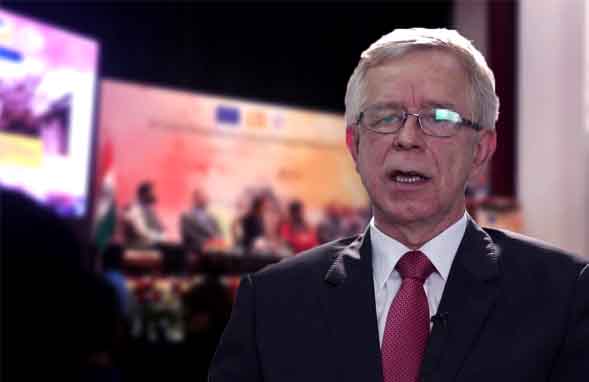Deliberations ranged from the impact of climate change on cultural heritage and the digital transformation of cultural heritage, to the importance of cultural heritage for socio-economic development and research opportunities.
EU-India Partnership for Cultural Heritage Conservation was held at the National Museum of India, New Delhi on December 4-5. The Opening session of the two-day conference was addressed by the Ambassador of the European Union to India, His Excellency Tomasz Kozlowski, and the Director General of the National Museum and Vice-Chancellor of the National Museum Institute, Dr B.R. Mani. Many other prominent speakers also spoke and emphasized the value of both tangible and non-tangible cultural heritage, giving rise to a diverse discourse around the matter.
The Ambassador’s Address
In the Key-note address, the European Union Ambassador to India affirmed that the two regions were natural partners which shared mutual understanding and common values, as well as rich cultural heritages. He informed the audience about the EU Parliamentary decision of declaring the year 2018 as the European Year of Cultural Heritage. His Excellency asserted the value of inter-cultural dialogue between the EU and India, reminding the audience that “We have a number of schemes which are important instruments for promoting such type of exchanges between Europe and India, like Erasmus Plus, Erasmus Mundus, Marie Curie scheme. Under such projects, we are happy to inform you that we have been able to exchange a lot of students, faculty members, researchers, including in the field of Cultural Preservation”.
Discussing the Europe digital platform for cultural heritage, the EU Ambassador said, “I would like to underline that in Europe we have developed a project which is called Europeana, which is Europe’s digital museum, which has more than 58 million objects from the best museums and archives in the EU on display. He highlighted the benefits of tourism too, highlighting that more than two million Europeans visited India and a similar figure was recorded for Indians visiting Europe in 2017.
The Ambassador spoke of the various projects already initiated under the EU-India partnership such as the Cultural Heritage & Management Venture Lab in Ahmedabad. The lab aims to create a Heritage ecosystem that promotes creative innovation, tourism and entrepreneurship. ‘Casa de la India’ or ‘India House’ in Valladolid, Spain plays an active role in the process. He added that culture sector contributed to 4.2% of EU GDP, and said a similar project can be created for India in the future with support from the European Union.
Expert Deliberation at the Conference
The deliberations between experts from India and Europe were divided into six sections over the course of two days.
The conference addressed socio-economic issues from a cultural heritage perspective and how the same can act as a catalyst for development. Ms Cecilia Costa, an EU delegation to India, informed the conference of the direct impact culture has on tourism as based on research as 27% of the European population focuses on cultural heritage when picking a destination. Tourism contributes Euro 450 billion to the European economy. Doctoral researcher and project manager for ‘The Lost Gardens of Khajuraho’, Nishant Upadhyay supported this hypothesis. Mr Upadhyay shared that the farmers in the area were taught to utilize their cultural heritage and produce some of the finest organic products, using local seeds available at a seed bank.
Effects of Climate Change
Experts from around the world highlighted the adverse impacts of constant climate change on cultural heritage monuments, artefacts and sites across the globe and discussed means to protect them. The CEO of Nanotech System for Applied Photocatalysis, Dr Frantisek Peterka, informed the conference about new technological advancements that can help protect cultural heritage. The expert from Czech Association of Applied Photocatalysis explained how he employed novel photoactive nanomaterials for the protection of Czechian cultural heritage.
Associate Professor Dr Satish C. Pandey from the National Museum Institute of India outlined the problems of India’s historic structures. His presentation comprised pictures highlighting the changing colour of the tiles and the eroding marble of India’s treasured Taj Mahal. Dr Johanna Leissner, on the other hand, discussed the need to monitor indoor climatic conditions, creating an environment within museums that would preserve the cultural artefacts for the long-term.
Many conservation architects at the conference promoted the idea of involving local communities to save old towns getting lost in urban cities. One such case was brought up by conservation architect, Ms Aishwarya Tapnis, who spoke of Chandernagore, a beautiful historic town lost within the city of Kolkata. The French-India project, ‘Bonjour India’ sought to restore the Indo-European cultural heritage of Chandernagore, and involved student volunteers from different Indian cities, including students from IIM Nagpur, who came up with strategies for restoring the town’s cultural heritage. A similar initiative called The Serampore Initiative was talked about by Dr Bente Wolff from the National Museum of Denmark.










